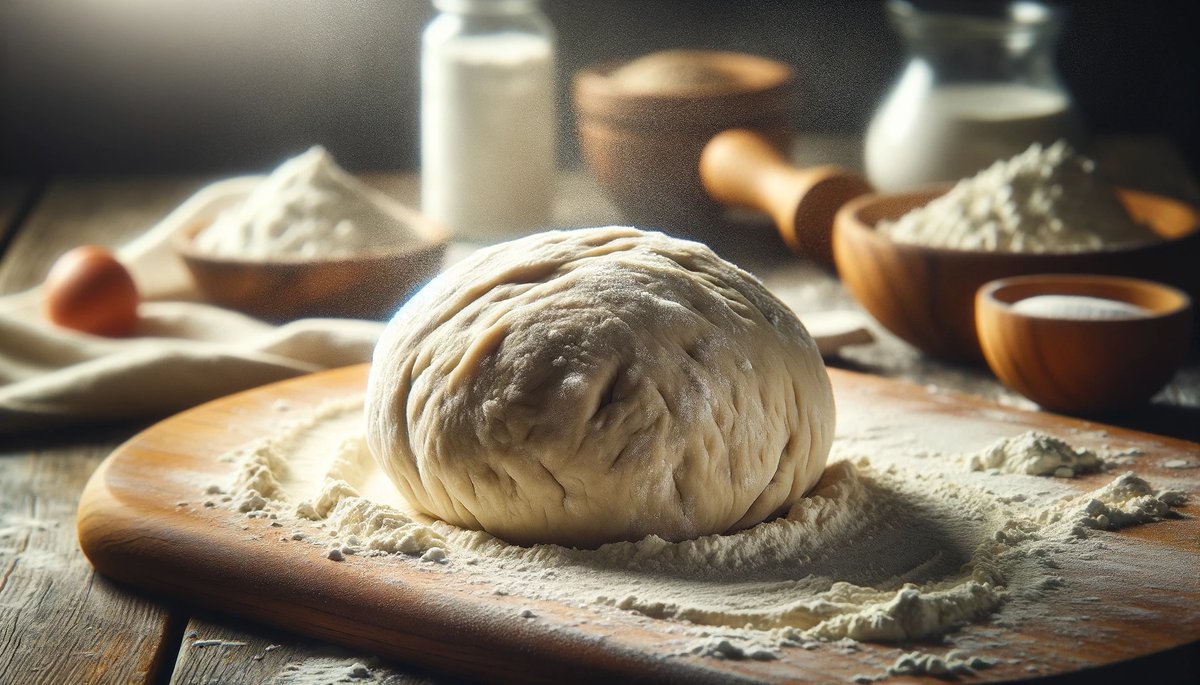Home>Theology and Spirituality>What Is The Wafer Of Communion Made From


Theology and Spirituality
What Is The Wafer Of Communion Made From
Published: February 25, 2024
Ericka Andersen, an editor at Christian.net, expertly merges digital strategy with content creation, focusing on faith and societal issues. Her communication skills enhance the platform's engaging narratives, fostering meaningful dialogue on belief's impact on society.
Discover the significance of the wafer of communion and its theological and spiritual implications. Learn about the materials used and the symbolism behind this sacred element. Explore the theology and spirituality of the communion wafer.
(Many of the links in this article redirect to a specific reviewed product. Your purchase of these products through affiliate links helps to generate commission for Christian.net, at no extra cost. Learn more)
Table of Contents
Introduction
The communion wafer, also known as the sacramental bread or the Eucharist, holds profound significance within Christian traditions. This sacred element is an integral part of the Eucharistic celebration, symbolizing the body of Christ and serving as a focal point of spiritual communion for believers. Understanding the composition, historical context, and spiritual significance of the communion wafer provides insight into the rich tapestry of Christian faith and practice. In this article, we will delve into the historical background, ingredients, production process, and the profound significance of the communion wafer in Christian tradition. Through this exploration, we aim to illuminate the spiritual and cultural importance of this sacred element, shedding light on its role in fostering spiritual connection and reverence within Christian communities.
Read more: What Is Communion Wafer
Historical Background of the Communion Wafer
The historical roots of the communion wafer can be traced back to the Last Supper, a pivotal event in Christian theology. According to the New Testament, during the Last Supper, Jesus Christ shared bread with his disciples, instructing them to partake of it as a symbol of his body. This act of sharing bread and wine, representing the body and blood of Christ, laid the foundation for the Eucharistic tradition within Christianity.
In the early Christian church, the practice of sharing bread and wine as symbols of Christ's body and blood became a central ritual in communal worship. The concept of the communion wafer evolved over time, influenced by cultural and theological developments within the Christian faith. As the Eucharistic celebration became more formalized, the use of unleavened bread, resembling the bread Jesus shared with his disciples, became customary in many Christian traditions.
Throughout history, the significance and symbolism of the communion wafer have been subject to theological debates and doctrinal interpretations within different branches of Christianity. The understanding of the real presence of Christ in the Eucharist, known as the doctrine of transubstantiation in Catholicism and the concept of spiritual presence in Protestantism, has shaped the theological perspectives on the communion wafer.
The communion wafer has also been intertwined with historical events and cultural practices. During the Middle Ages, the production and distribution of communion wafers were regulated by ecclesiastical authorities, and intricate rituals surrounded their handling and consumption. The Reformation era brought about diverse views on the Eucharist, leading to variations in the understanding and observance of the communion wafer among different Christian denominations.
In contemporary times, the communion wafer continues to hold a central place in Christian liturgy and worship. Its historical significance as a symbol of Christ's sacrificial love and spiritual nourishment endures, serving as a tangible link to the rich tapestry of Christian history and tradition.
The historical background of the communion wafer provides a compelling narrative of its evolution within the Christian faith, reflecting the enduring influence of the Last Supper and the profound theological insights that have shaped its significance over the centuries.
Ingredients of the Communion Wafer
The ingredients of the communion wafer are of utmost importance, as they reflect the reverence and care with which this sacred element is prepared. Traditionally, the communion wafer, also known as altar bread, is made from unleavened wheat flour and water. The simplicity of these ingredients underscores the symbolic purity and humility associated with the body of Christ in Christian theology.
Unleavened wheat flour, a key component of the communion wafer, holds deep symbolic significance within the Christian tradition. The absence of leaven, which is a fermenting agent, represents purity and sincerity, aligning with the solemnity and sanctity of the Eucharistic ritual. This choice of flour reflects the scriptural accounts of the Last Supper, where Jesus used unleavened bread to symbolize his body, emphasizing the unadorned nature of his sacrifice.
Water, the other essential ingredient, serves to bind the flour together, forming the dough from which the communion wafers are made. The use of water in this process symbolizes the life-giving and purifying aspects of Christ's teachings, reinforcing the spiritual nourishment and cleansing that believers seek through the Eucharistic celebration.
While the traditional recipe for the communion wafer consists solely of unleavened wheat flour and water, variations exist within different Christian denominations and cultural contexts. Some communities may incorporate a minimal amount of salt into the mixture, symbolizing the preservation of faith and the covenant between God and humanity. However, the fundamental simplicity and purity of the ingredients remain consistent across these variations, underscoring the profound spiritual symbolism embedded in the communion wafer.
The careful selection and preparation of these ingredients reflect the reverence and spiritual significance attributed to the communion wafer within Christian worship. The process of transforming basic elements into the sacred vessel for communion embodies the profound theological and symbolic dimensions of the Eucharistic ritual, emphasizing the central role of the communion wafer in fostering spiritual communion and reverence within Christian communities.
The Process of Making the Communion Wafer
The process of making the communion wafer is a meticulous and reverent endeavor, reflecting the sacred nature of this essential element in Christian worship. The traditional method of crafting the communion wafer involves precise steps that honor its symbolic significance and spiritual purpose.
-
Preparation of the Dough: The process commences with the careful blending of unleavened wheat flour and water to form a smooth, homogeneous dough. This initial stage symbolizes the unity and integrity of Christ's body, emphasizing the purity and simplicity inherent in the Eucharistic ritual.
-
Rolling and Cutting: Once the dough is prepared, it is meticulously rolled out to achieve a consistent thickness, ensuring uniformity in the communion wafers. The use of a circular cutter results in perfectly round wafers, signifying the completeness and wholeness of Christ's sacrificial love and spiritual nourishment offered to believers.
-
Pricking and Baking: Before baking, the surface of the dough is pricked with a specialized tool to prevent air pockets from forming during the baking process. This act of pricking symbolizes the piercing of Christ's body during the crucifixion, serving as a poignant reminder of his redemptive sacrifice. The wafers are then baked until they achieve a delicate, pale appearance, signifying the purity and sanctity of the Eucharistic elements.
-
Packaging and Storage: Once baked, the communion wafers are carefully packaged and stored in a reverent manner, ready to be used in the sacred celebration of the Eucharist. The utmost care is taken to ensure the integrity and purity of the wafers, reflecting the reverence and solemnity with which they are regarded within Christian liturgical practice.
The meticulous process of making the communion wafer underscores the profound spiritual and symbolic dimensions of the Eucharistic ritual. Each step in the production of the wafer embodies the reverence and care with which it is prepared, serving as a tangible expression of the sacred connection between the physical elements of the Eucharist and the spiritual nourishment they provide to believers.
This detailed process not only ensures the quality and integrity of the communion wafers but also encapsulates the deep theological significance and spiritual resonance that permeate the Eucharistic celebration within Christian worship.
The Significance of the Communion Wafer in Christian Tradition
The communion wafer holds profound significance within Christian tradition, serving as a focal point of spiritual communion and a tangible representation of the central tenets of the faith. Its significance can be understood through multiple dimensions, each contributing to its revered status within Christian worship.
Read more: What Does A Communion Wafer Represent
Symbolism of Christ's Sacrifice
The communion wafer symbolizes the body of Christ, as signified during the Last Supper, where Jesus shared bread with his disciples, instructing them to partake of it as a representation of his body. This symbolic act underscores the sacrificial love and redemptive purpose of Christ, emphasizing the foundational belief in his atoning sacrifice for the salvation of humanity. As believers partake of the communion wafer, they are reminded of Christ's selfless offering and are invited to participate in the spiritual nourishment and grace that emanate from this profound act of love.
Spiritual Nourishment and Unity
In partaking of the communion wafer, believers affirm their spiritual connection to Christ and to one another as members of the Christian community. The act of sharing the Eucharistic elements fosters a sense of unity and fellowship, transcending individual experiences and affirming the communal bond that unites believers in their shared faith. The communion wafer thus becomes a tangible expression of spiritual nourishment, sustaining and strengthening the faithful as they partake in the Eucharistic celebration.
Continuity with Tradition and History
The communion wafer serves as a link to the historical and theological foundations of the Christian faith. Its use in the Eucharistic ritual reflects the continuity of practice from the early Christian church to the present day, embodying the enduring significance of the Last Supper and its reverberations throughout Christian history. By partaking of the communion wafer, believers engage in a timeless tradition that connects them to the rich tapestry of Christian heritage, reinforcing their identity as inheritors of a faith that spans centuries and continents.
Reverence and Solemnity
The handling and consumption of the communion wafer are characterized by reverence and solemnity, underscoring its sacred nature within Christian worship. The meticulous preparation and careful distribution of the wafer reflect the deep respect and awe with which it is regarded, emphasizing the sanctity of the Eucharistic elements and the spiritual gravity of the act of communion. This reverence extends to the physical vessel of the wafer, which is treated with utmost care and devotion, embodying the profound respect for the spiritual significance it embodies.
In essence, the communion wafer holds multifaceted significance within Christian tradition, encapsulating the core principles of sacrificial love, spiritual nourishment, historical continuity, and reverent communion. Its centrality in the Eucharistic celebration underscores its pivotal role in fostering spiritual connection, communal unity, and reverence within Christian communities, making it a cherished symbol of faith and devotion for believers across denominational boundaries.
Read more: Who Makes The Communion Wafers
Conclusion
The communion wafer, with its rich historical legacy, profound symbolism, and spiritual significance, stands as a timeless emblem of Christian faith and devotion. From its origins in the Last Supper to its enduring presence in contemporary Eucharistic celebrations, the communion wafer embodies the core tenets of Christian theology and serves as a tangible conduit for spiritual communion and reverence.
The historical background of the communion wafer unveils a narrative of continuity and evolution within Christian tradition. Rooted in the foundational events of the Last Supper, the communion wafer has traversed centuries of theological discourse, cultural adaptations, and doctrinal interpretations, shaping its significance as a symbol of Christ's sacrificial love and spiritual nourishment.
The ingredients and meticulous process of making the communion wafer reflect the reverence and care with which this sacred element is prepared. The simplicity of unleavened wheat flour and water, combined with the precise steps involved in crafting the wafer, underscores its sanctity and symbolic purity, emphasizing the profound theological and spiritual dimensions of the Eucharistic ritual.
The communion wafer's significance within Christian tradition extends beyond its material form, encompassing multifaceted dimensions of symbolism, spiritual nourishment, historical continuity, and reverent communion. As believers partake of the communion wafer, they are invited to engage with the foundational truths of their faith, affirming their connection to Christ, to one another, and to the enduring legacy of Christian heritage.
In conclusion, the communion wafer stands as a poignant embodiment of the central themes of Christian faith – sacrificial love, spiritual nourishment, communal unity, and historical continuity. Its enduring presence in the Eucharistic celebration serves as a testament to the profound impact of the Last Supper and its reverberations throughout Christian history. As believers partake in the sacred act of communion, the communion wafer remains a tangible expression of their faith, fostering spiritual connection, communal fellowship, and reverence for the transformative power of Christ's love.













